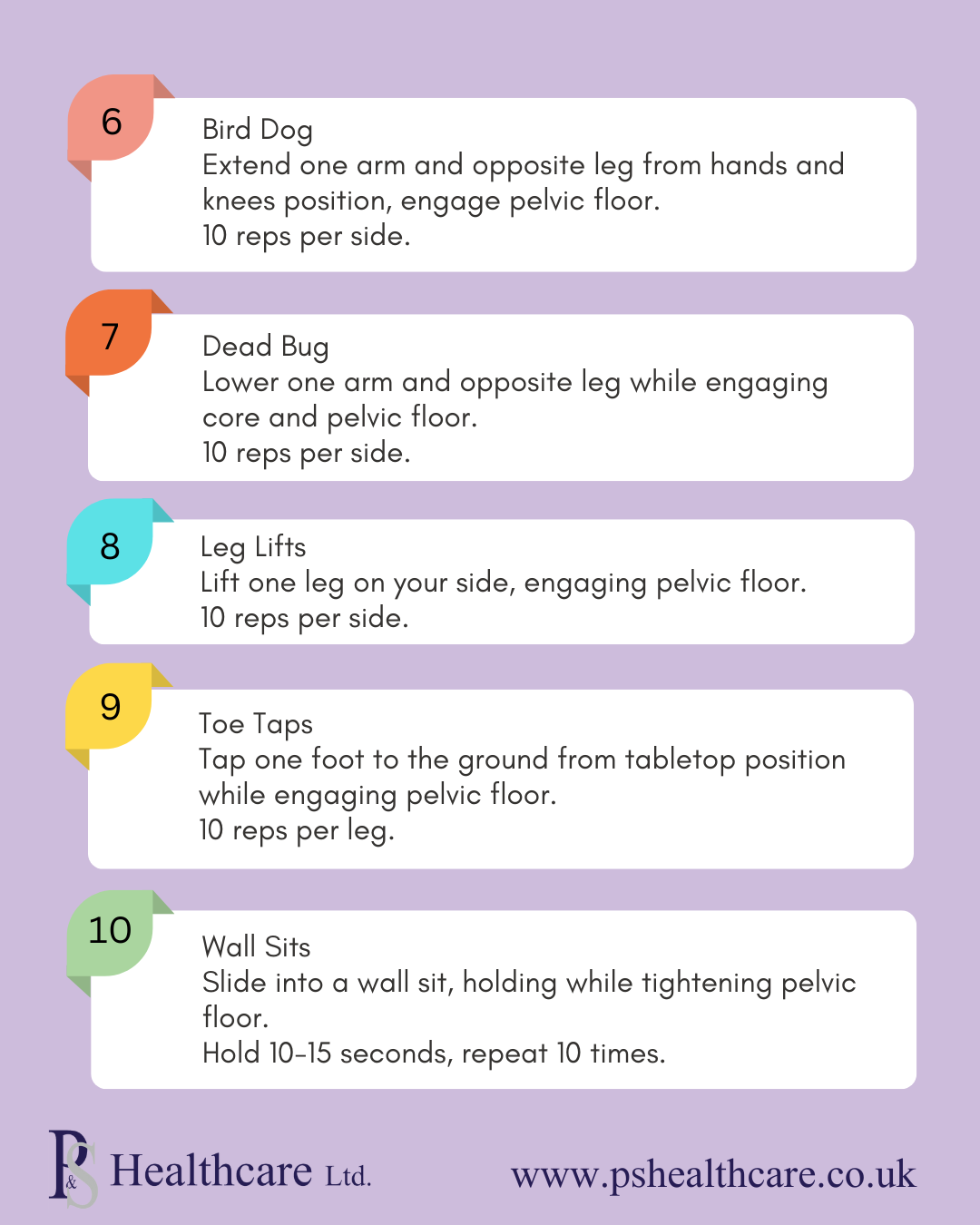10 Effective Pelvic Floor Exercises for Urinary Incontinence

Urinary incontinence can be a challenging condition, impacting daily life and confidence. Fortunately, strengthening your pelvic floor muscles can offer substantial relief. These muscles support the bladder and control urine flow, so building their strength can improve bladder control. Here are ten effective pelvic floor exercises to help manage urinary incontinence.
1. Kegel Exercises
Kegel exercises are the foundation of pelvic floor strengthening. Start by identifying your pelvic floor muscles: try to stop your urine flow mid-stream; the muscles you engage are your pelvic floor muscles.
How to do it: Contract these muscles for five seconds, then release for five seconds.
Reps: Aim for three sets of 10 reps daily.
2. Quick Flicks
This exercise builds the muscle fibres responsible for quick contractions, helping control sudden urges to urinate.
How to do it: Quickly contract and relax your pelvic muscles in rapid succession.
Reps: Do this for 10 reps, three times a day.
3. Bridge Exercise
While typically a core exercise, the bridge is beneficial for strengthening the pelvic floor.
How to do it: Lie on your back, knees bent, feet flat. Lift your hips while engaging your pelvic floor and glute muscles. Hold for five seconds, then lower.
Reps: Complete three sets of 10 reps.
4. Squats
Squats are great for overall lower body strength and can also engage the pelvic floor muscles.
How to do it: Stand with feet hip-width apart, lower into a squat position while tightening your pelvic floor. Return to standing, maintaining control.
Reps: Aim for two sets of 10 reps.
5. Heel Slides
Heel slides are low-impact but work effectively to strengthen core and pelvic floor muscles.
How to do it: Lie on your back with knees bent. Slowly slide one heel down until your leg is straight, then return to the starting position. Engage your pelvic floor throughout.
Reps: Perform 10 reps per side.
6. Bird Dog
Bird dog exercises enhance stability and engage the pelvic floor.
How to do it: Start on hands and knees, extend one arm and the opposite leg. Engage your core and pelvic floor to hold the position, then switch sides.
Reps: Do 10 reps per side.
7. Dead Bug
This exercise strengthens the pelvic floor and core, which supports bladder control.
How to do it: Lie on your back, arms pointing up, knees at a 90-degree angle. Slowly lower one arm and the opposite leg while keeping your pelvic floor engaged. Return to the start, then switch sides.
Reps: Do 10 reps per side.
8. Leg Lifts
Leg lifts are gentle but effective for pelvic floor strengthening.
How to do it: Lie on your side, lift your top leg while keeping it straight. Engage your pelvic floor muscles as you lift.
Reps: Complete 10 reps on each side.
9. Toe Taps
Toe taps work the core and pelvic floor, helping with bladder control.
How to do it: Lie on your back, knees raised to a tabletop position. Slowly tap one foot to the ground, keeping your pelvic floor engaged. Alternate legs.
Reps: Do 10 reps per side.
10. Wall Sits
This isometric exercise strengthens the lower body and pelvic floor.
How to do it: Stand with your back against a wall, slide down into a seated position, and hold while tightening your pelvic floor.
Reps: Hold for 10-15 seconds, repeat 10 times.
Tips for Success
Consistency is Key: Aim to perform these exercises daily.
Start Slow: If you’re new to pelvic floor exercises, begin with just a few repetitions, gradually increasing as you get stronger.
Focus on Breathing: Breathe deeply throughout each exercise, avoiding holding your breath.
Avoid Other Muscle Groups: Try not to tighten your thighs, glutes, or abs excessively. Focus on isolating the pelvic floor muscles.
Why Pelvic Floor Exercises Matter
Strengthening your pelvic floor can improve bladder control, reduce the frequency of urinary incontinence episodes, and boost overall quality of life. These exercises can be done anytime, anywhere, offering a convenient and accessible way to manage symptoms.
For more personalised advice or if symptoms persist, consult a healthcare professional. They can guide you on the best regimen for your needs.
Download our handy infographic below for a quick reference guide:


More News:
- Why Ladies Washable Incontinence Pants Are Better for the Planet
- Understanding Why Older Children Still Wet the Bed and What You Can Do About It
- Travelling with Incontinence: Best Washable Incontinence Pants for Men on the Go
- Your Guide to Washable Incontinence Pants for Ladies: FAQs Answered
- The Benefits of Switching to Washable Incontinence Products
- 8 Everyday Activities That Can Strengthen or Weaken Your Bladder
- 10 Things You Should Pack in an Incontinence Emergency Kit
- 10 Foods to Eat and Avoid for Better Bowel Control
- 8 Ways Stress and Anxiety Can Affect Bladder Health
- 10 Signs It's Time to See a Doctor About Your Urinary Incontinence
- 10 Tips for Talking to Your Child About Bedwetting
- 10 Things You Should Know About Postpartum Incontinence
- 10 Common Triggers of Urinary Incontinence in Women Over 50
- 10 Tips for Night-Time Incontinence Management in Adults
- 10 Ways to Manage Incontinence While Playing Sports
- 10 Tips for Managing Faecal Incontinence in Adults
- 10 Lifestyle Changes to Manage Urinary Incontinence Symptoms
- 10 Ways to Manage Urinary Incontinence During Pregnancy
- 10 Causes of Urinary Incontinence in Men and How to Treat Them
- 10 Practical Solutions for Coping with Incontinence at Work
- 10 Myths About Menopause and Incontinence You Should Stop Believing
- 10 Foods to Avoid to Prevent Bladder Irritation and Incontinence
- 10 Effective Pelvic Floor Exercises for Urinary Incontinence
- 10 Common Causes of Bedwetting in Children and How to Address Them
- Causes of Faecal Incontinence
- Breaking the Silence: Managing Incontinence with Confidence
- Supporting Loved Ones with Incontinence: A Caregiver's Guide
- Top 10 Tips for Managing Incontinence Comfortably This Christmas
- Pregnancy and Postpartum Incontinence: Prevention and Recovery
- 10 Random Facts About Pee You Probably Didn't Know
- Diet and Bladder Health: Foods That Help and Hurt
- Helping Your Child Manage Incontinence: A Parent's Resource
- The Most Common Bladder Control Problems and How to Manage Them
- 10 Things That Can Make Incontinence Worse
- Incontinence Myths vs Facts - Dispelling Common Misconceptions
- Top 10 tips to help with bladder control during pregnancy
- 10 Effective Ways to Stop Bladder Leaks & Manage Incontinence
- P&S Washable Face Mask with ViralOff
- New Product For Men - The Slip Brief
- New Monthly Protection Briefs For Women
- New Product - The OooPS Pant for Stress Incontinence
- New Adult Inco-elite Range Launched
- EMDA WOMEN OF WORTH AWARD 2009
- New Website Launched
- New Website Under Development

